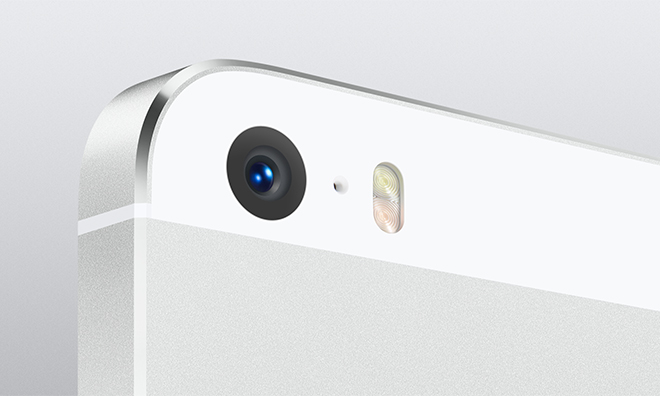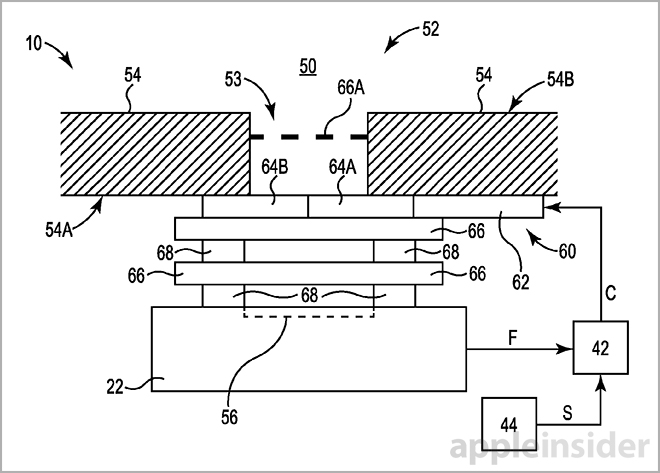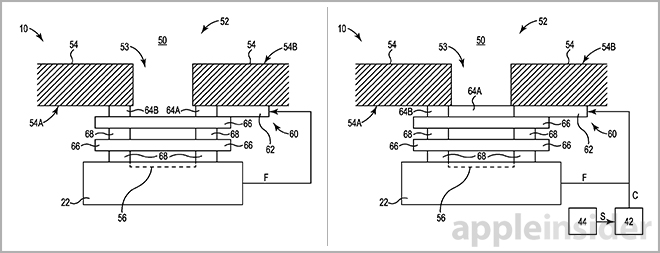Apple tech would use mechanical shutters to protect sensitive iPhone audio components
Last updated
The U.S. Patent and Trademark Office on Thursday published an Apple patent application covering an active system that protects sensitive acoustic components like microphones and speakers from damage.
As the state of smartphone technology advances, so do the internal components being used in their construction, including increasingly sensitive — and increasingly small — electronics like acoustic sensors and emitters. While mesh grilles and foam were sufficient in protecting previous generations of devices, future smartphones may require more active measures.
Apple's filing for "Active protection for acoustic device" describes a mechanical system that takes input from motion sensors, as well as other internal measurement devices, to actuate a shutter or valve that closes off an acoustic component's passage. Once closed, the sensitive acoustic device is protected from sudden changes in pressure, air bursts and acoustic shock, among other threats.
As noted in the filing, the acoustic components can be microphones and speakers disposed on the front face of a portable device, as well as the bottom, down-firing configuration seen in the iPhone. An acoustic passage serves to direct and in some cases amplify or resonate audio waves into and out of the device.
At the same time, these passages can be detrimental when a phone is dropped, as an unwanted pressure event could rupture or otherwise damage the acoustic part. Scenarios of an air burst may include a face-down drop or exposure to high-intensity external acoustic fields like extremely loud music.
Apple's invention proposes the device use onboard sensors, such as an accelerometer or gyroscope, to sense an impending fall or shock event. With the information, the system can activate a mechanism to close or seal the acoustic passage prior to contact.
In some cases, the acoustic component itself can sense heightened pressure levels and actuate the mechanism to fully or partially seal off the passage accordingly. This particular embodiment relies on generating an audio signal, opening the protection mechanism to sample said signal and measuring it against a threshold indicative of being over a predefined pressure differential.
As for the closure system, the filing describes a shutter or valve setup that can be operated by solenoids to seal the outer acoustic port or inner acoustic passage. In another embodiment, a solid state system incorporates a microelectromechanical system (MEMS) via gear drive, stepped motor or other applicable mechanism. Both variations rely on a control signal from either the motion sensor array or audio tests described above.
As Apple's devices become more advanced with multiple microphones for noise canceling, multiple speakers for stereo sound and other acoustic enhancements, there may soon come a time when an active protection system is needed.
Acceleration in miniaturization techniques and demand for high-quality audio could push the company to release such a mechanism in the not too distant future, though Apple is not expected to immediately incorporate the technology into its iOS device lineup.
Apple's acoustic component protection system patent application was first filed for in 2012 and credits Kelvin Kwong as its inventor.
 Mikey Campbell
Mikey Campbell
















 Amber Neely
Amber Neely
 Thomas Sibilly
Thomas Sibilly
 AppleInsider Staff
AppleInsider Staff
 William Gallagher
William Gallagher
 Malcolm Owen
Malcolm Owen
 Christine McKee
Christine McKee










12 Comments
Hurray Apple! Your attention to detail continues to go far beyond mere beauty and aesthetics. There is hope after Steve... there is hope! Keep it up Apple!
Before we realize what is happening, our iPhones will be able to form an ad hoc neural network and become self-aware.
[quote name="SpamSandwich" url="/t/179918/apple-tech-uses-mechanical-shutters-to-protect-sensitive-iphone-audio-components/0_100#post_2537874"]Before we realize what is happening, our iPhones will be able to form an ad hoc neural network and become self-aware.[/quote]Ahh. So then it won't be Arnold but our cell phones that will rise up and deal the first strike against humanity. Where's John Conner when you need him......
I don't want all these cosmetic things! Please fix Cloud and Software services. I strongly believe Apple had achieved near nirvana in Hardware. Apple, please concentrate on Software an services and connected components pleaseeee!
[quote name="Lord Amhran" url="/t/179918/apple-tech-uses-mechanical-shutters-to-protect-sensitive-iphone-audio-components#post_2537881"] Ahh. So then it won't be Arnold but our cell phones that will rise up and deal the first strike against humanity. Where's John Conner when you need him......[/quote] I'd prefer if my iPhone morphed into Cylon 6. I could live with that. :D